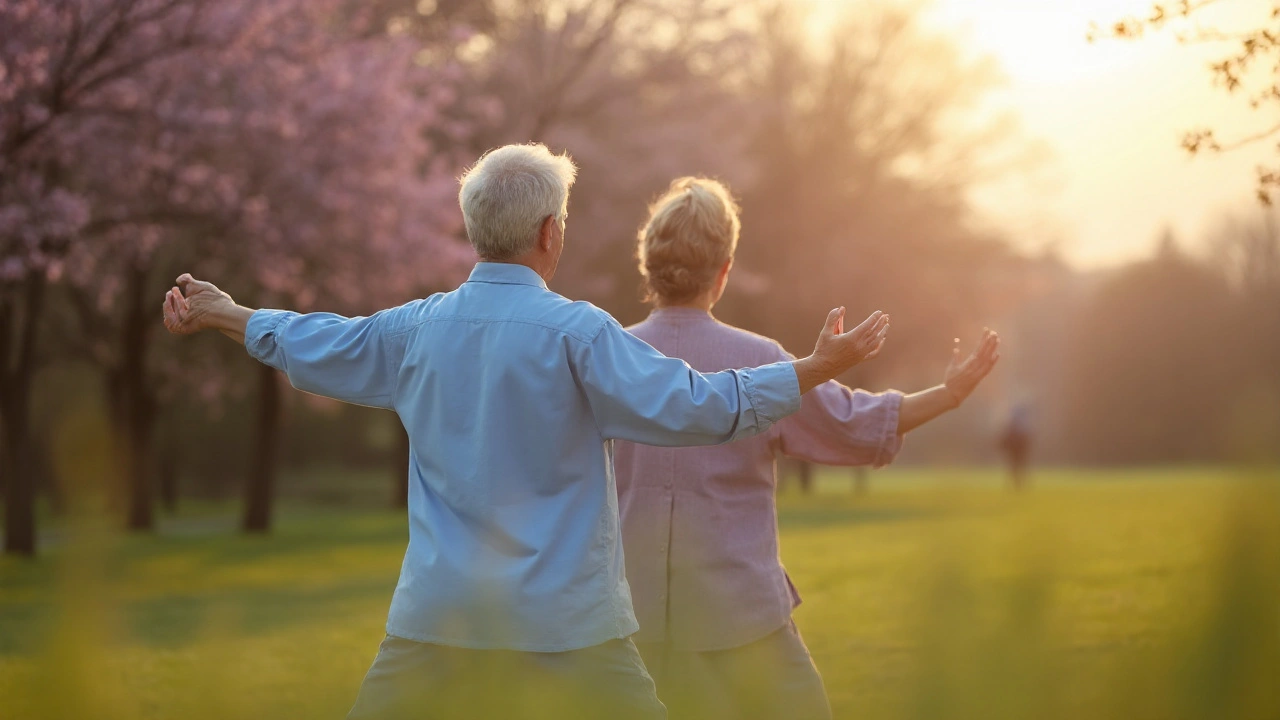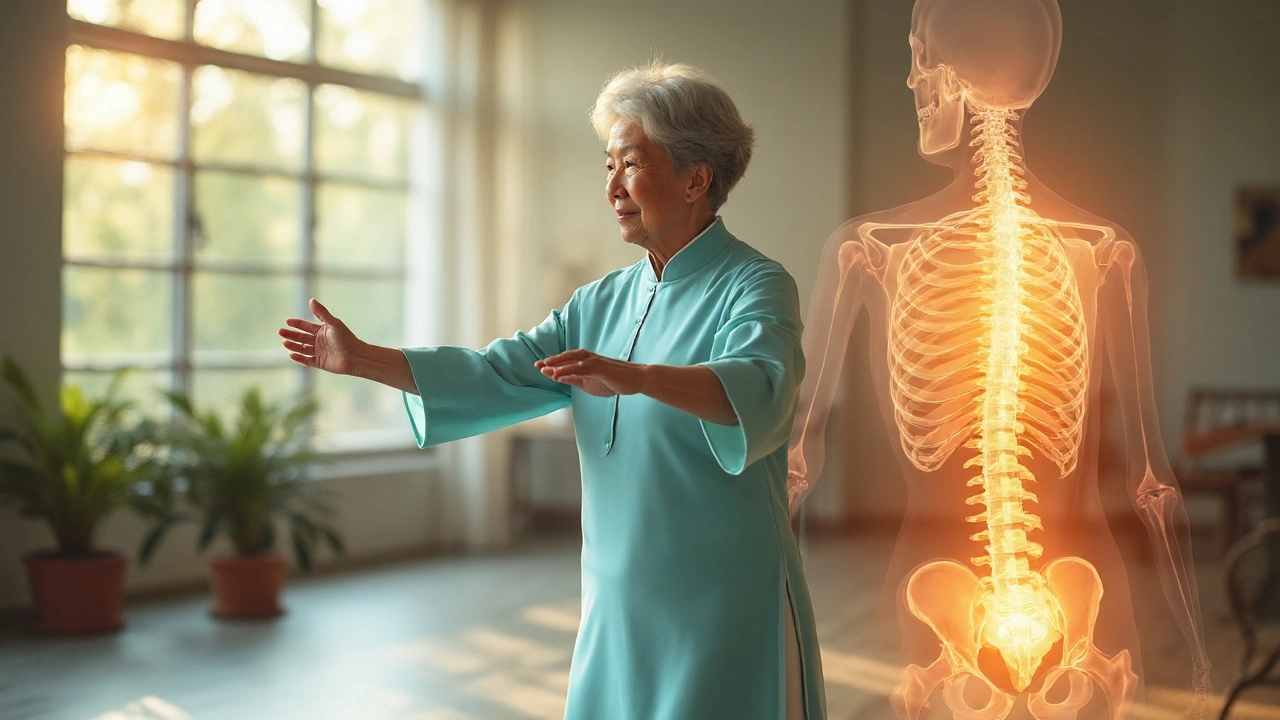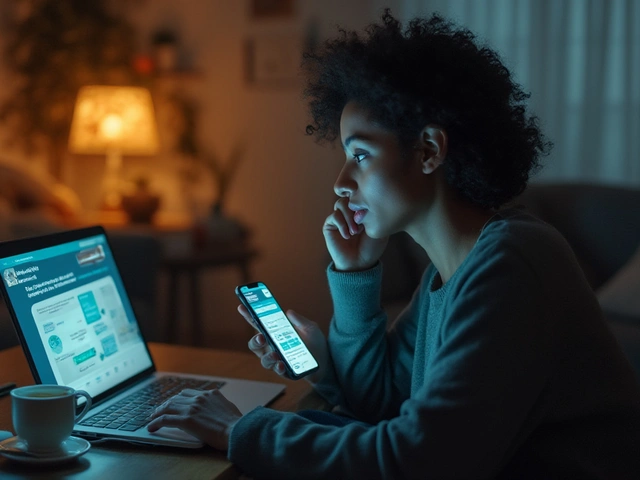
Tai Chi is a slow‑motion, mind‑body martial art that emphasizes fluid movement, breath control and mental focus. Practitioners move through a series of postures that flow together like a gentle dance, making it ideal for anyone who wants a safe way to stay active. People with Osteoporosis is a progressive disease that thins bone tissue and raises the risk of fractures often wonder if they can find an exercise that won’t shake their skeleton. The answer lies in a practice that’s low‑impact yet powerful enough to boost strength, balance and confidence. Below you’ll find a quick snapshot, a deep dive into the science, and a roadmap to start moving today.
TL;DR - Quick Takeaways
- Tai Chi improves bone mineral density (BMD) by up to 2% in 12‑months.
- It reduces fall risk by enhancing balance and proprioception.
- Sessions as short as 20minutes, three times a week, already show benefits.
- Low‑impact nature makes it safe for most osteoporosis stages.
- Compared to yoga or strength training, Tai Chi scores highest for balance improvement.
Understanding Osteoporosis and What Matters
Bone Mineral Density is a measure of the amount of mineral (mostly calcium) packed into a specific volume of bone, expressed in g/cm². Lower BMD means bones break more easily. Doctors track BMD with a DEXA scan and use the FRAX score is a calculator that estimates a 10‑year probability of a major osteoporotic fracture. While medication can slow bone loss, lifestyle choices-especially safe exercise-play a huge role in keeping the skeleton sturdy.
Two key risk factors are Fall Risk is a likelihood of losing balance and hitting the ground, which can turn a minor slip into a serious fracture for someone with weak bones and Proprioception is a body’s sense of where its limbs are in space, critical for making quick corrective movements. Strengthening these areas can dramatically lower the chance of a break.
Why Tai Chi Targets the Core Problems
When you practice Tai Chi, each movement forces you to shift weight, rotate the torso and control the descent of a pose. Those actions create gentle, multidirectional loading on the skeleton-exactly the kind of stimulus bone cells need to stay alive. Unlike high‑impact aerobics, the forces stay below the threshold that could cause micro‑fractures.
Balance improves because you’re constantly training the vestibular system (inner ear), visual cues and the muscles that keep you upright. The slow pace lets the brain fine‑tune proprioceptive feedback, turning shaky steps into smooth, confident moves.
Mentally, the meditative breathing reduces cortisol, a stress hormone that can accelerate bone loss. Lower stress also means better sleep, which is another factor that helps bone remodeling.
Scientific Snapshot - What the Research Says
Several peer‑reviewed studies back up the hype:
- In a 2022 randomized trial with 180 post‑menopausal women, 12 months of Tai Chi (3×45min/week) raised lumbar spine BMD by 1.8% compared to a control group that stayed sedentary.
- A 2021 meta‑analysis of 9 trials (n=1,025) reported a 30% reduction in falls among osteoporosis patients who practiced Tai Chi for at least 6 months.
- Researchers from the National Osteoporosis Foundation found that participants who combined Tai Chi with calcium‑vitaminD supplements improved their FRAX score by an average of 4 points.
These numbers line up with data from the World Health Organization, which lists Tai Chi as a “recommended low‑impact activity for bone health.”

How to Start - A Practical Guide
- Find a qualified instructor. Look for certifications from the American Tai Chi Association or a local senior‑center program.
- Begin with 20‑minute sessions. Focus on 5 basic forms: Commencing, Ward Off, Roll Back, Press, and Push.
- Frequency. Aim for three sessions per week; consistency beats intensity.
- Safety checks. Keep a chair nearby for support during first weeks, and avoid deep knee bends if you have joint pain.
- Complementary habits. Pair practice with 1,200mg of calcium and 800IU of vitaminD daily, plus weight‑bearing steps like short walks.
Progression looks like adding more complex sequences, increasing hold time of each posture, and eventually moving to a group class where you can practice with a partner-an extra boost for proprioception.
How Tai Chi Stacks Up Against Other Exercises
| Exercise | Impact Level | Balance Gain | Bone Loading | Accessibility |
|---|---|---|---|---|
| Tai Chi | Very Low | High | Moderate (multidirectional) | High - minimal equipment |
| Yoga (Hatha) | Low | Medium | Low (static holds) | High - many studios |
| Strength Training (machines) | Low‑Moderate | Low‑Medium | High (targeted loads) | Medium - equipment needed |
| Walking | Low | Low | Very Low | Very High - no gear |
Notice that Tai Chi leads the pack for balance while still delivering enough gentle load to keep bone cells busy. Strength training scores highest for pure bone loading but falls short on safety for many older adults unless supervised closely.
Related Concepts and Next Steps
If Tai Chi clicks, you might also explore Qigong, a sister practice that focuses more on breath and static postures. Both fit into the broader mind‑body exercise category alongside yoga and Pilates. For those who need a rehab boost, physiotherapy programs often incorporate Tai Chi movements to improve gait and lower‑limb strength.
Future topics to dig into include "Combining Tai Chi with VitaminD Supplementation" and "Using Wearable Sensors to Track Proprioception Gains". Those articles will show how a holistic plan can tighten the safety net around bone health.
Frequently Asked Questions
Can Tai Chi replace medication for osteoporosis?
No. Exercise, including Tai Chi, works best alongside prescription meds. It can slow bone loss and cut fall risk, but it doesn’t address the hormonal factors that drugs target.
How soon will I notice a difference in balance?
Most people feel steadier after 4‑6 weeks of regular practice. Objective tests (e.g., timed up‑and‑go) often show a 10‑15% improvement within two months.
Is Tai Chi safe for someone with spinal fractures?
Yes, provided the instructor modifies movements. Avoid deep forward bends and use a chair for support during the first weeks.
How often should I practice to see bone density gains?
Three 45‑minute sessions per week for at least 12 months produced measurable BMD improvements in clinical trials.
Do I need special shoes or equipment?
Flat, flexible shoes with a thin sole are ideal. A sturdy chair or wall can serve as a safety aid, but no weights or machines are required.
Can Tai Chi help with osteoporosis‑related back pain?
Yes. The gentle spinal rotations improve circulation and muscle support around the vertebrae, often easing chronic aches.
Is there an age limit for starting Tai Chi?
No. Classes are offered for seniors, beginners, and even adults in their 30s. The key is to start slowly and respect your body’s limits.




5 Comments
I started Tai Chi last year after a minor fall scared me silly. Didn’t think I’d stick with it, but now I do it every morning before coffee. My balance is way better - I can stand on one foot without grabbing the counter. And honestly? My back pain’s eased up too. No magic pill, just slow, steady movement. It’s like my bones finally got a hug.
Also, the instructor at the community center is this 78-year-old guy who’s got more grace than most 20-year-olds. Made me realize age ain’t the enemy - stiffness is.
Don’t overthink it. Just show up. Even 15 minutes counts.
i just wanna say i tried tai chi after reading this and omg it changed my life. i have osteo and was scared to move but this is so gentle. i do it in my living room with a chair next to me. no fancy gear, no gym membership. just me, my breath, and a little bit of peace.
also i spelled ‘osteoporosis’ wrong like 5 times in my notes lol. sorry.
but seriously - if you’re on the fence, just try one class. you won’t regret it.
My mom’s been doing Tai Chi for 3 years. She broke her wrist at 68, then started this. Now she hikes, dances at weddings, and doesn’t need a cane. The science checks out - but what really matters is how it makes you feel. Confident. Grounded. Like your body still works.
Start with YouTube videos if you’re shy. Look for ‘Tai Chi for beginners osteoporosis’ - there are tons of 20-minute ones. Do it barefoot on carpet. No pressure. Just move.
From India, and yeah we’ve had this stuff for centuries - Qigong, Tai Chi, all that. But here’s the thing nobody says: it’s not about the bones. It’s about the mind learning to trust the body again.
I saw my aunt go from fearing stairs to walking 3 miles without help. Not because she lifted weights. Because she learned to feel her feet. That’s the real win.
And yes, vitamin D helps. But if you’re scared to move, no supplement’s gonna save you. Movement is the medicine. The rest is just garnish.
So let me get this straight - you’re telling me the answer to osteoporosis is… slow dancing with your own skeleton?
Meanwhile, Big Pharma is over here selling calcium pills like they’re candy.
Who profits from Tai Chi? Not the pharmaceutical industry. Not the gym chains. Not even the yoga mat companies.
It’s too quiet. Too simple. Too… peaceful.
Maybe that’s why it works.
Or maybe we’re just being manipulated by ancient Chinese mystics who hate capitalism.
Either way I’m trying it. But I’m keeping my protein shakes.